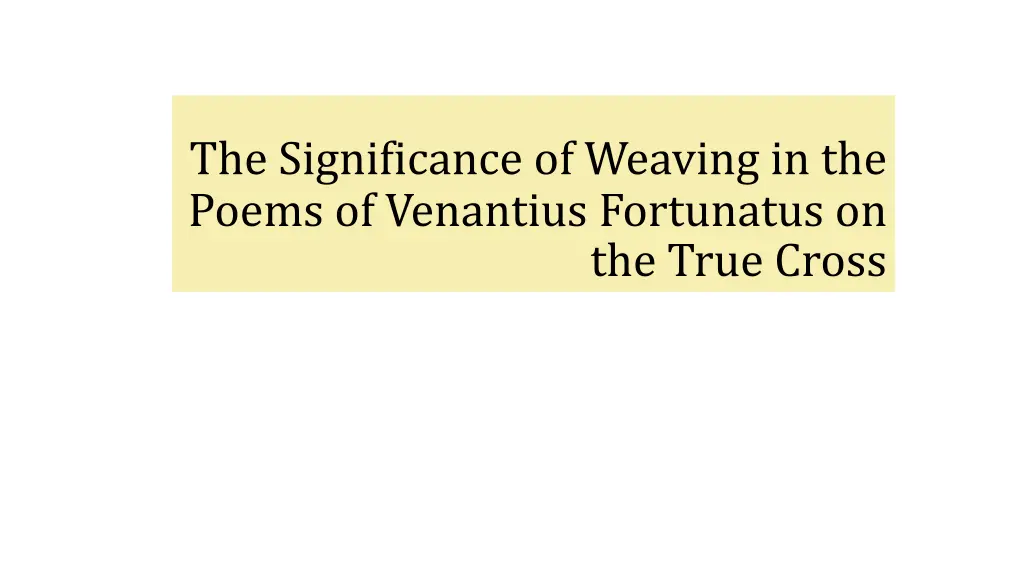
Weaving Symbolism in Venantius Fortunatus' True Cross Poems
Explore the significance of weaving in the poems of Venantius Fortunatus on the True Cross, delving into the intricate connections between art, craftsmanship, and poetic expression. Witness the poetic tapestry that intertwines elements of creativity and symbolism, unveiling a deeper understanding of the intertwining threads of literature and visual artistry within the Merovingian Court.
Download Presentation

Please find below an Image/Link to download the presentation.
The content on the website is provided AS IS for your information and personal use only. It may not be sold, licensed, or shared on other websites without obtaining consent from the author. If you encounter any issues during the download, it is possible that the publisher has removed the file from their server.
You are allowed to download the files provided on this website for personal or commercial use, subject to the condition that they are used lawfully. All files are the property of their respective owners.
The content on the website is provided AS IS for your information and personal use only. It may not be sold, licensed, or shared on other websites without obtaining consent from the author.
E N D
Presentation Transcript
The Significance of Weaving in the Poems of Venantius Fortunatus on the True Cross
Lawrence Alma-Tadema, Venantius Fortunatus Reading His Poems to Radegonda VI, 1862 from Veneto, studied in Ravenna - poet at the Merovingian Court in Metz Radegund - wrote over 300 poems Venantius Fortunatus (c. 530-600 CE)
Tradition of Figural Acrostics Porphryius Optatianus Biblioth que nationale de France, D partement des Manuscrits
Explanation of acrostic 'weaving' to Syagrius referencing Horace's Ars poetica: considerans versiculum, si quae vult artifex permiscet uterque, cur non, etsi non ab artifice, misceantur utraque, ut ordiretur una tela simul poesis et pictura? considering this verse, I wondered if each artist mixes together whatever he wants, why should the methods of both of them not be intermingled, even if not by an artist, so that one single web be set up, at the same time both a poem and a picture? littera vero quae tinguitur in descendenti versiculo, et tenetur in uno et currit in altero et, ut ita dicatur, et stat pro stamine et pro trama currit in tramite, ut esse potest in pagina: licia litterata. indeed any letter that is dyed in the descending verse is held fast in the one and runs crossways in the other; it both stands upright, so to speak, as the warp, and runs crosswise as the weft so that it might be, as far as it is possible on the page, a lettered loom.
de signaculo sanctae crucis vertical borders dulce decus signi, via caeli, vita redempti sweet glory of the sign, road to heaven, life of the redeemed in cruce mors cristi curavit mortua mundi the death of Christ on the cross cured the world s deaths cross as a tree bearing the fruit of Christ, axis mundi on the page arbor suavis agri, tecum nova vita paratur delightful tree of the field, because of you a new life is prepared en regis magni gemmantem et nobile signum behold the jeweled and noble standard of the great king (crux gemmata) crux pia, devotas Agnen tege cum Radegunde venerable cross, protect the devoted women Agnes and Radegund tu Fortunatum fragilem, crux sancta, tueredefend, Holy Cross, the frail Fortunatus Biblioth que nationale de France, Paris
top lines on the Trinity lines forming the cross ditans templa dei, crux, et velamen adornasO cross, you enrich the temples of God and you embellish its veils/sails (vela) crux, agnus sic pater et genitus sic scs spiritus unus thus the Father, thus the Son, thus the Holy Spirit, One Biblioth que nationale de France, Paris
possibility of the poems as textile designs? - patronage of Radegund: Rule of Caesarius - Byzantine hand draw-loom: pattern-weaving mechanism
sources Brennan, Brian. Weaving with Words: Venantius Fortunatus s Figurative Acrostics on the Holy Cross. Traditio, vol. 74 (2019): 27-53. https://archivesetmanuscrits.bnf.fr/ark:/12148/cc67057f https://gallica.bnf.fr/ark:/12148/btv1b10020274q/f5.item






















